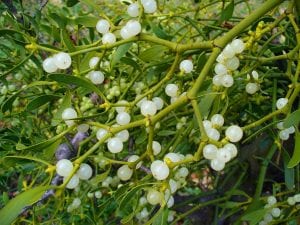Long-Term Mesothelioma Survival with Mistletoe Extract
 Mesothelioma researchers are calling for more study of compounds extracted from European mistletoe after a German pleural mesothelioma patient survived for more than four years with no other treatment.
Mesothelioma researchers are calling for more study of compounds extracted from European mistletoe after a German pleural mesothelioma patient survived for more than four years with no other treatment.
Pleural mesothelioma is an aggressive cancer caused by exposure to asbestos. Although many different types of new mesothelioma treatments are under investigation, there is no cure.
An Alternative Mesothelioma Treatment?
Most mesothelioma patients receive some combination of surgery, chemotherapy, and/or radiation. But a new report in the Journal of Thoracic Disease suggests that long-term mesothelioma survival might be possible with an alternative treatment modality called viscum album extracts (VAE).
VAE is extracted from the European mistletoe plant and is known to stimulate the immune system, downregulate cancer genes, and inhibit the formation of new blood vessels that tumors need to grow. VAE has rarely been investigated in mesothelioma.
Another extract, from a plant known as Christmas Rose (Helleborus niger), has also been shown to be toxic to cancer cells. This is known as HNE.
Complementary Therapy for Pleural Mesothelioma
When German doctors were confronted with a 64-year-old woman with Stage III pleural mesothelioma who did not want to use any of the standard mesothelioma treatments, the decision was made to treat her with a combination of VAE and HNE.
Given that the average survival for a person diagnosed with pleural mesothelioma is less than 18 months, regardless of what treatment modality they choose, the results of the study are notable.
“After six weeks’ treatment, the pleural and nodal malignant pleural mesothelioma manifestations were reduced by about 15 percent,” writes study author Paul G Werthmann of the Institute for Applied Epistemology and Medical Methodology in Freiburg. “Subsequent tumor growth was slow and the patient remained in good health, enabling her to remain physically active until shortly before her death 56 months after the initial diagnosis.”
Mesothelioma Treatment and Quality of Life
The German study is not only important because of the patient’s unusually long mesothelioma survival, but also because the patient did not appear to be negatively impacted by the treatment.
Standard mesothelioma treatments, including radical or conservative surgery, systemic and localized chemotherapy, and radiotherapy all come at a cost. Radical mesothelioma surgery such as EPP carries an especially high risk of complications, including serious breathing difficulties and low energy afterwards.
The chemotherapy for mesothelioma can cause vomiting, diarrhea, low blood cell counts, and skin rashes. Radiotherapy can damage the lungs over time and result in permanent breathing problems.
But, at least in the current case, the side effects of VAE and HNE were minimal and allowed the mesothelioma patient to enjoy a high quality of life for the remainder of her life. While this experimental treatment combination may not be for every patient, the German team says it deserves to be studied more carefully.
“We presume that VAE and HNE might have had an impact on this clinically relevant outcome and therefore should be further investigated in malignant pleural mesothelioma,” concludes the report.
Source:
Werthmann, PG, et al, “Minor regression and long-time survival (56 months) in a patient with malignant pleural mesothelioma under Viscum album and Helleborus niger extracts-a case report”, December 9, 2017, Journal of Thoracic Disease, pp. 1064-1070





